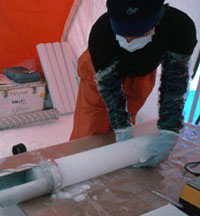Ice cores
Scientists from the British Antarctic Survey are drilling ice cores in the Antarctic and analysing them to find out what the Earth’s temperature and carbon dioxide levels were like in the past.
In this video, Ice Core Scientist Nerilie Abram reveals how we recover and study ice through the ages, and how this gives us an insight into how the Earth’s climate is changing.
Ice and temperature

Members of the British Antarctic Survey recovering an ice core © British Antarctic Survey
Ice and water are made up of oxygen and hydrogen. Scientists study the oxygen atoms in ice cores to reveal past temperatures.
There are 2 common types (isotopes) of oxygen atom, known as 18O and 16O, which have different weights. Ice that contains a high proportion of 16O was formed when the Earth's temperature was low, while ice containing lots of 18O was formed in warmer temperatures.
This method is called isotope analysis. Isotope analysis can be used to find out about past temperatures from samples of fossils, such as corals and bryozoans, as well as from samples of ice.
Gases trapped in the ice
One of the main advantages of analysing ice cores is that they show levels of carbon dioxide in the atmosphere at different points in Earth’s history, as well as recording temperature. Many of the other methods of calculating past temperatures don’t do this.
Air bubbles remain trapped in the ice. Scientists use these to find out the concentration of greenhouse gases like carbon dioxide and methane.
The ice also stores traces of other substances, like salt, which is transported by wind from the ocean. This helps scientists to calculate the amount of sea ice surrounding the polar regions.
The link between carbon dioxide and temperature
Analysis of ice cores has shown that when carbon dioxide levels are high, so is global temperature.
Levels of carbon dioxide and methane have both increased dramatically in the last 50 years as a result of human activity, such as carbon emissions from aeroplanes, cars and power stations. They are now much higher than at any other time in the last three quarters of a million years.
Finding the age of ice
To analyse past temperature scientists have to be able to work out the age of the ice they are studying.
An ice core is like a timeline – the newest ice lies closest to the surface while ice that was formed thousands, or even millions, of years ago is deeply buried.
Scientists find out the age of the ice by comparing the isotopes in each layer to existing records of the Earth's climate.
To make sure their dating is accurate, they also look at significant features in the ice core. These include layers of dust, or small amounts of the chemical sulphuric acid, which are evidence of big volcanic eruptions. Scientists know the dates of many of these events and so they can use them to check the age of the ice core.
Scientists also know how quickly ice usually forms in particular regions of the world and this helps them work out when each section of an ice core was formed.
Antarctica is thought to have been covered by ice for over 30 million years. So far, scientists have drilled ice cores stretching back 800,000 years, and they are now working to extend their records back to 1.4 million years ago.
